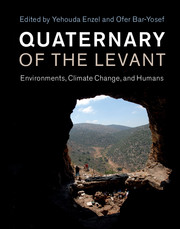Book contents
- Quaternary of the Levant
- Quaternary of the Levant
- Copyright page
- Contents
- Contributors
- Acknowledgements
- 1 The Quaternary of the Levant
- Part I: The Evolution of Current Landscapes and Basins
- Part II: Palaeoclimates
- Part III: Archaeology of Human Evolution
- Part IV: Palaeoecology
- Part V: Quaternary Geomorphology
- Part VI: Humans in the Levant
- 59 The Acheulian of the Levant
- 60 The Palaeolithic Sequence in Southeast Turkey
- 61 Lower and Middle Palaeolithic of Lebanon
- 62 The Lower Palaeolithic of Syria
- 63 The Lower Palaeolithic of Jordan
- 64 The Middle Palaeolithic of Southern Jordan
- 65 Middle Palaeolithic Open-Air Sites
- 66 A Hominid ‘Archetype’
- 67 Neanderthals and Modern Humans in the Levant: An Overview
- 68 Human Fossils from the Upper Palaeolithic through the Early Holocene
- 69 The Initial Upper Palaeolithic in the Levant
- 70 The Upper Palaeolithic in Cisjordan
- 71 The Early and Middle Epipalaeolithic of Cisjordan
- 72 The Early Epipalaeolithic in the Eastern Levant
- 73 The Upper and Epipalaeolithic of Southern Jordan
- 74 The Upper and Epipalaeolithic of the Azraq Basin, Jordan
- 75 Late Quaternary Refugia, Aggregations, and Palaeoenvironments in the Azraq Basin, Jordan
- 76 The Epipalaeolithic and Pre-Pottery Neolithic of Lebanon
- 77 The Natufian Culture
- 78 The Natufian Period in Syria
- 79 Natufian and Early Neolithic in the Black Desert, Eastern Jordan
- 80 The Archaeology of Early Farming in Southeast Turkey
- 81 Early Agriculture in the Southern Levant
- 82 Domesticating Plants in the Near East
- 83 The Neolithic of Southern Jordan
- 84 The Beginning of Animal Domestication and Husbandry in Southwest Asia
- 85 Environmental Change and Society in Holocene Prehistory
- Index
- Plate section
- References
72 - The Early Epipalaeolithic in the Eastern Levant
Wadi al-Hasa Region
from Part VI: - Humans in the Levant
Published online by Cambridge University Press: 04 May 2017
- Quaternary of the Levant
- Quaternary of the Levant
- Copyright page
- Contents
- Contributors
- Acknowledgements
- 1 The Quaternary of the Levant
- Part I: The Evolution of Current Landscapes and Basins
- Part II: Palaeoclimates
- Part III: Archaeology of Human Evolution
- Part IV: Palaeoecology
- Part V: Quaternary Geomorphology
- Part VI: Humans in the Levant
- 59 The Acheulian of the Levant
- 60 The Palaeolithic Sequence in Southeast Turkey
- 61 Lower and Middle Palaeolithic of Lebanon
- 62 The Lower Palaeolithic of Syria
- 63 The Lower Palaeolithic of Jordan
- 64 The Middle Palaeolithic of Southern Jordan
- 65 Middle Palaeolithic Open-Air Sites
- 66 A Hominid ‘Archetype’
- 67 Neanderthals and Modern Humans in the Levant: An Overview
- 68 Human Fossils from the Upper Palaeolithic through the Early Holocene
- 69 The Initial Upper Palaeolithic in the Levant
- 70 The Upper Palaeolithic in Cisjordan
- 71 The Early and Middle Epipalaeolithic of Cisjordan
- 72 The Early Epipalaeolithic in the Eastern Levant
- 73 The Upper and Epipalaeolithic of Southern Jordan
- 74 The Upper and Epipalaeolithic of the Azraq Basin, Jordan
- 75 Late Quaternary Refugia, Aggregations, and Palaeoenvironments in the Azraq Basin, Jordan
- 76 The Epipalaeolithic and Pre-Pottery Neolithic of Lebanon
- 77 The Natufian Culture
- 78 The Natufian Period in Syria
- 79 Natufian and Early Neolithic in the Black Desert, Eastern Jordan
- 80 The Archaeology of Early Farming in Southeast Turkey
- 81 Early Agriculture in the Southern Levant
- 82 Domesticating Plants in the Near East
- 83 The Neolithic of Southern Jordan
- 84 The Beginning of Animal Domestication and Husbandry in Southwest Asia
- 85 Environmental Change and Society in Holocene Prehistory
- Index
- Plate section
- References
Summary
- Type
- Chapter
- Information
- Quaternary of the LevantEnvironments, Climate Change, and Humans, pp. 651 - 658Publisher: Cambridge University PressPrint publication year: 2017

